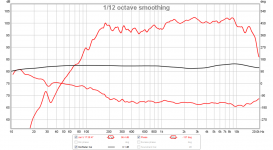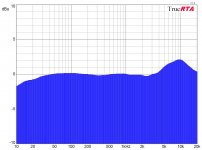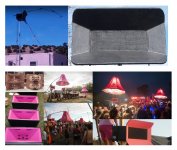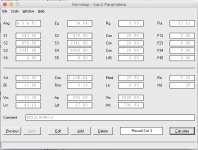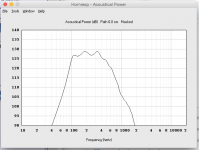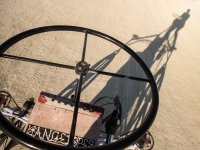EDIT TO LAST POST - that wasn't the Dayton rep it was the Cross Spectrum Labs rep. That's what I meant, not sure where my mind was wandering...
Yeah, I mentioned a few times in previous posts that it won't make any difference with sub frequencies.
The problem is in the tweeter range, as one poster points out -
I guess I got lucky because my mic produces frequency sweeps of known drivers that match factory provided freq response curves. Furthermore they also provide measurements that match my sims on a tapped horn sub. If I look at my cal file it has very mild corrections of order 1 to 1.5dB at the very low end and very high end. I agree for another $20 the calibrated ones from this other company seems to be a good deal.
Also, it seems that JG (who is temporarily out of action until she relocates) got pretty good agreement between her UMM-6 measurement and sims for the subject sub in this thread.
Yeah, I mentioned a few times in previous posts that it won't make any difference with sub frequencies.
The problem is in the tweeter range, as one poster points out -
I think anyone can download any cal file from PE (I grabbed half-a-dozen once, just to compare them).
They all seemed to have a common "rhythm" to them (at the time), which I figured were artifacts from Dayton's (or PE's) measuring setup or environment.
One year (a few years back) I won an EMM-6 that had the cal file to download (from PE) but was ALSO calibrated by CSL. The cal files did not match, not even closely. The CSL file had the standard looking (panni condenser mic capsule) curve that you've seen online. PE's had that weird "rhythm" of rises and falls in the upper octaves, which I'd have to conclude were bogus.
Here is an example of one of my measurements of the Nautaloss speaker with the UMM-6 showing the mic calibration correction curve. The cal file has about +/-1.1dB max corrections in the higher octaves. That is not going to change things that much.
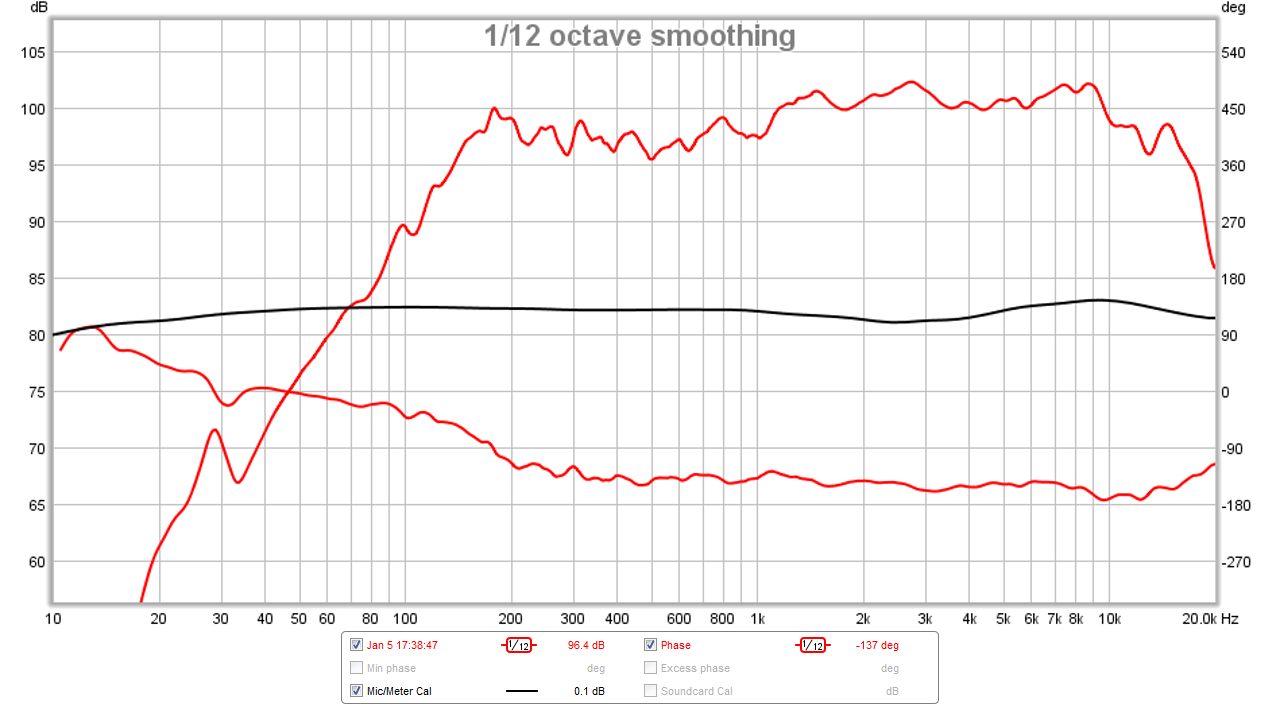

Attachments
Here is an example of one of my measurements of the Nautaloss speaker with the UMM-6 showing the mic calibration correction curve. The cal file has about +/-1.1dB max corrections in the higher octaves. That is not going to change things that much.
I'm happy that you are happy with your mic, and I certainly can't argue with that.
But in one of the links I showed earlier it was clearly shown with measurements that with one of the Dayton mics the cal file was so bad you could get more accurate results without using the cal file at all.
The Dayton cal files are not accurate, I've dug up a few links to prove that (most of them have measurements so it's not an opinion) and posted them here. IMO it's well worth the few extra $$$ to get an accurate mic. +/- 1.1 db can add up to a sizable error, especially if it's over a fairly wide bandwidth.
Sad those microphone stories, it can be discussed if +/- 1,1 db somewhere the line a microphone that price point is bad, but if the unique file downloaded for my serienumber haven't got any real relation to the device it's madness and scams. Attach plot my UMM-6 calibration file, it's more or less contour as xrk971's one.
Attachments
Last edited:
Sad those microphone stories, it can be discussed if +/- 1,1 db somewhere the line a microphone that price point is bad, but if the unique file downloaded for my serienumber haven't got any real relation to the device it's madness and scams. Attach plot my UMM-6 calibration file, it's more or less contour as xrk971's one.
Chris Roemer has mentioned several times in different threads that the inaccuracy appear to be an artifact of the measuring setup or environment. He's downloaded a bunch of different cal files and they all have the same characteristic peaks that don't show up in cal files of the same mic from a reputable mic calibrator.
Here's an example from the most recently linked thread. Same mic, two different cal files, one from Dayton (black), one from Cross Spectrum Labs (pink). This sawtooth garbage, especially in the tweeter range is the problem. The biggest difference is 3 db (at about 8 khz) and much less over most of the bandwidth between the Dayton and the professionally calibrated file so you could say it isn't a big deal, but really, do you want to work with that?
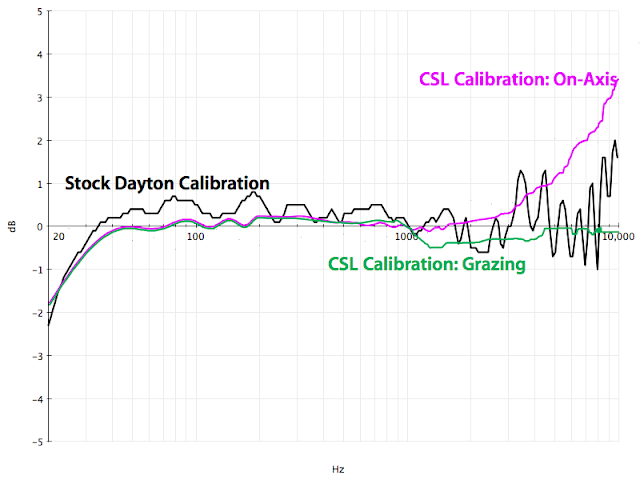
Thanks "just a guy" though it's irritating info to look at. Just bought the UMM-6 a couple months ago to have a calibrated microphone to replace my known un-calibrated ECM8000. At least i can use them local to compare measurements when doing tweaks, and also maybe some comfort that both my and XRK971 calibration files seems they don't have the sawtooth contour (my RTA plot is 1/24oct - 20db vertical axe).
Last edited:
Yes little comfort not having a saw-tooth calibration file it give some hope. Xrk971 if remember right when you got your UMM-6 in the start you published some Holm measurements and short after migrated to REW as analyzer and your published measurements always have looked consistent and realistic.
The CSL rep did say Dayton's cal files have improved over the last couple of years but didn't give any details. I think all three threads I posted links to here were within the last year though, with new mics. Here's the previous links (with measured comparisons to pro calibrations) in case anyone missed them.
This one didn't have the sawtooth issue but it was still off by quite a bit, new mic last year. http://techtalk.parts-express.com/s...oss-Spectrum-EMM-6&highlight=calibration+file
This one did have the sawtooth issue, new mic last year (and note that using no cal file was better than using the Dayton cal file). http://techtalk.parts-express.com/showthread.php?237654-Dayton-iMM-6-measurement-progress
Dayton (and PE) refuse to comment on the issue and I've never seen anyone post a comparison showing that a newer mic did well against a professional calibrated unit. If the sawtooth garbage is no longer an issue that's a big step in the right direction but I remain skeptical.
I'm in the market for a mic AND an impedance tester. I could save over $100 with Dayton products but these two particular products have serious flaws that have been known issues for years that Dayton will not admit or even talk about (until it became a sales feature for their redesigned DATS). I'm actually trying to hold off on buying a $160 WT2 to see if forthcoming reviews say the new DATS is still a quirky piece of junk after the redesign.
This one didn't have the sawtooth issue but it was still off by quite a bit, new mic last year. http://techtalk.parts-express.com/s...oss-Spectrum-EMM-6&highlight=calibration+file
This one did have the sawtooth issue, new mic last year (and note that using no cal file was better than using the Dayton cal file). http://techtalk.parts-express.com/showthread.php?237654-Dayton-iMM-6-measurement-progress
Dayton (and PE) refuse to comment on the issue and I've never seen anyone post a comparison showing that a newer mic did well against a professional calibrated unit. If the sawtooth garbage is no longer an issue that's a big step in the right direction but I remain skeptical.
I'm in the market for a mic AND an impedance tester. I could save over $100 with Dayton products but these two particular products have serious flaws that have been known issues for years that Dayton will not admit or even talk about (until it became a sales feature for their redesigned DATS). I'm actually trying to hold off on buying a $160 WT2 to see if forthcoming reviews say the new DATS is still a quirky piece of junk after the redesign.
Last edited:
Hi just a guy, think UMM-6 and DATS is classed for hobby/starter semipro use, if you a pro producer and need pro precision reference gear you probably have a budget that suits the higher price for other brands, i just mention this because think sometimes our demands take overhand.
Regarding the DATS ( my is DATS v1 hardware) device i had my own for about 2 years and recommend it for hobby/semipro. Opposite the UMM-6, one is able to check the device precision by own hand, just measure a reference resistor/inductor/capacitor and if not satisfied result, return the deal or get a exchange one. Precisely following the instruction in the manual for use i have never had flaws or inconsistency when measured drivers dynamic-microphones resistors inductors capacitors and cables. From what i see the new DATS v2 hardware just better in warm up time, the v1 was ½ min. and the older WT3 1½ min.
If my setup route in the PC is better than standard i don't know but i have a good quality USB3 PCIe card (Renesas chipset and serious power filters which should be cleaner than motherboard buils in ones) dedicated the DATS device or my external soundcard.
Regarding the DATS ( my is DATS v1 hardware) device i had my own for about 2 years and recommend it for hobby/semipro. Opposite the UMM-6, one is able to check the device precision by own hand, just measure a reference resistor/inductor/capacitor and if not satisfied result, return the deal or get a exchange one. Precisely following the instruction in the manual for use i have never had flaws or inconsistency when measured drivers dynamic-microphones resistors inductors capacitors and cables. From what i see the new DATS v2 hardware just better in warm up time, the v1 was ½ min. and the older WT3 1½ min.
If my setup route in the PC is better than standard i don't know but i have a good quality USB3 PCIe card (Renesas chipset and serious power filters which should be cleaner than motherboard buils in ones) dedicated the DATS device or my external soundcard.
Hi Y'all,
What would be a good place to get a mike calibrated?
Regards,
Cross Spectrum Labs is the only one I know of. But with the cost of shipping both ways and the cal service you might as well just buy a new one from them.
Hi just a guy, think UMM-6 and DATS is classed for hobby/starter semipro use, if you a pro producer and need pro precision reference gear you probably have a budget that suits the higher price for other brands, i just mention this because think sometimes our demands take overhand.
Regarding the DATS ( my is DATS v1 hardware) device i had my own for about 2 years and recommend it for hobby/semipro. Opposite the UMM-6, one is able to check the device precision by own hand, just measure a reference resistor/inductor/capacitor and if not satisfied result, return the deal or get a exchange one. Precisely following the instruction in the manual for use i have never had flaws or inconsistency when measured drivers dynamic-microphones resistors inductors capacitors and cables. From what i see the new DATS v2 hardware just better in warm up time, the v1 was ½ min. and the older WT3 1½ min.
If my setup route in the PC is better than standard i don't know but i have a good quality USB3 PCIe card (Renesas chipset and serious power filters which should be cleaner than motherboard buils in ones) dedicated the DATS device or my external soundcard.
Even the Dayton Product Manager says it has known issues. (Now that it's a sales feature for their new redesigned unit.) Here's a quote
Much of this difficulty is because Microsoft has changed the way recording levels are handled in the Windows audio subsystem in Windows Vista, 7, and 8, and none of them are the same. Our Quick Start Guide covers the different setup procedures needed for each operating system, and the procedure is different for each version of Windows after XP. At work, I leave the DATS plugged into my Windows 7 based desktop PC at all times (I just added a little stick-on hook to coil the cable onto). Occasionally I still have problems, but it's usually resolved by saving all my data, closing all my open programs, restarting the PC with the DATS connected, and completing the Quick Start procedure again, then launching the DATS software.
Also keep in mind that the DATS requires a warm-up time of 90 seconds (1.5 min.) before performing a full-power measurement. I have experienced some instability when performing multiple measurements right after one another, but letting the DATS rest for another 90 seconds usually restores normal operation. The cause of this instability is known and is being fixed in a future revision to the hardware. We are working to try to make measurements using DATS less temperamental, since we want the DATS product to be easy and a pleasure to use.
Here's a quick thread where I've listed a few of the more recent discussions of the flaws of this device - http://www.diyaudio.com/forums/subwoofers/246716-dayton-dats-info-2.html
There's a thread every month or so, everything from DOA units to instability to cheap build quality. A lot of people just are not following the instructions properly, but this product just doesn't work properly.
Sorry for the long hiatus! I am pulling this sub out of storage today, where it has been sitting on its side for 18 months 
Time to build a mid bass and complete the setup. Now it is going on a bicycle trailer w/ mobile DJ setup on top. Looking forward to sharing more as this project ramps up for me.
Initial plan is to continue with the dims I had for the synergy horn, but since the whole setup will be only inches off of the ground, I would like to situate the compression driver up top on a rack that covers the DJ equipment, while using the sub and mids as the table. So, probably not going to be a synergy horn but a 3 way stack of sorts.
More to come. It's good to be back here and awesome to see that a lot of people are still posting!
Time to build a mid bass and complete the setup. Now it is going on a bicycle trailer w/ mobile DJ setup on top. Looking forward to sharing more as this project ramps up for me.
Initial plan is to continue with the dims I had for the synergy horn, but since the whole setup will be only inches off of the ground, I would like to situate the compression driver up top on a rack that covers the DJ equipment, while using the sub and mids as the table. So, probably not going to be a synergy horn but a 3 way stack of sorts.
More to come. It's good to be back here and awesome to see that a lot of people are still posting!
Welcome back, did you then ever see weltersys's Synergy build http://www.diyaudio.com/forums/mult...-2-part-virtual-single-point-source-horn.html.
Attachments
Nice! I remember when he started the synergy tripp thread way back when. I just skimmed the build thread and looks awesome. Have to read more!
I spent the night simming a front loaded midbass with dual 10CL51's, nothing really that fancy but it's what I can handle for the moment
Since my latest use for this sub is on a mobile bicycle trailer, I fear that a synergy horn mounted up high would need lots of structural support which would likely make it a bit top heavy, not good for going downhill around corners. I would ideally like to keep most of the weight closer to the ground.
Not opposed to the idea, though, maybe it could be mounted telescopically (lowered before transporting and raised up when stopped / dj active)
Here is what I have so far for a dual 10CL51 FLH midbass to match the 28-100hz FS215 and HF144 CD(s) I have. I am still tweaking, so [as always] please be my guest if you have suggestions. Right now I am thinking my throat chamber volume might be a bit too high and I'm loosing too much in the high frequencies. Was hoping that I can crossover somewhere in between 500-750hz to the HF144
I spent the night simming a front loaded midbass with dual 10CL51's, nothing really that fancy but it's what I can handle for the moment
Since my latest use for this sub is on a mobile bicycle trailer, I fear that a synergy horn mounted up high would need lots of structural support which would likely make it a bit top heavy, not good for going downhill around corners. I would ideally like to keep most of the weight closer to the ground.
Not opposed to the idea, though, maybe it could be mounted telescopically (lowered before transporting and raised up when stopped / dj active)
Here is what I have so far for a dual 10CL51 FLH midbass to match the 28-100hz FS215 and HF144 CD(s) I have. I am still tweaking, so [as always] please be my guest if you have suggestions. Right now I am thinking my throat chamber volume might be a bit too high and I'm loosing too much in the high frequencies. Was hoping that I can crossover somewhere in between 500-750hz to the HF144
Attachments
Nice! I remember when he started the synergy tripp thread way back when. I just skimmed the build thread and looks awesome. Have to read more!
I spent the night simming a front loaded midbass with dual 10CL51's, nothing really that fancy but it's what I can handle for the moment
Since my latest use for this sub is on a mobile bicycle trailer, I fear that a synergy horn mounted up high would need lots of structural support which would likely make it a bit top heavy, not good for going downhill around corners. I would ideally like to keep most of the weight closer to the ground.
Not opposed to the idea, though, maybe it could be mounted telescopically (lowered before transporting and raised up when stopped / dj active)
Here is what I have so far for a dual 10CL51 FLH midbass to match the 28-100hz FS215 and HF144 CD(s) I have. I am still tweaking, so [as always] please be my guest if you have suggestions. Right now I am thinking my throat chamber volume might be a bit too high and I'm loosing too much in the high frequencies. Was hoping that I can crossover somewhere in between 500-750hz to the HF144
A bicycle-drawn Synergy horn? This sounds, um, interesting! (My other hobby is building bikes.)

I have one of those Harbor Freight DIY trailers, and I've daydreamed about making a mini-Caleb. Basically a scaled down version of the Danley Caleb. Only problem is I have absolutely no use for it! But it would be a fun project.
Ahhhhh thank you SO much for reminding me about the harbor freight trailers! It is absolutely the best solution... then I can tow it long distance with a car as well 
Well if you are into bikes, then this post is for you. Here is the bike that will be pulling the system. I welded most of it up a few years back, then made some improvements this past August... including a 36V 500W motor assist and extended cargo capacity to hold a 800W on board generator which continuously recharges the e-bike battery if needed. It already has a small tripath system with a couple of 4" FE126EN's in ported boxes, but it is simply not enough.
Anyone willing to look over my sim above? I am admittedly a little bit rusty in hornresp. It has been a while
Thanks for the interest and the suggestions guys!
Well if you are into bikes, then this post is for you. Here is the bike that will be pulling the system. I welded most of it up a few years back, then made some improvements this past August... including a 36V 500W motor assist and extended cargo capacity to hold a 800W on board generator which continuously recharges the e-bike battery if needed. It already has a small tripath system with a couple of 4" FE126EN's in ported boxes, but it is simply not enough.
Anyone willing to look over my sim above? I am admittedly a little bit rusty in hornresp. It has been a while
Thanks for the interest and the suggestions guys!
Attachments
- Status
- This old topic is closed. If you want to reopen this topic, contact a moderator using the "Report Post" button.
- Home
- Loudspeakers
- Subwoofers
- FaitalPRO 15HP1060 vs 3015LF for tapped horn?
